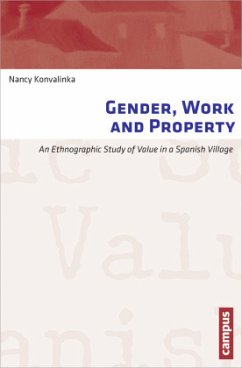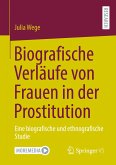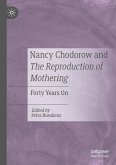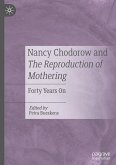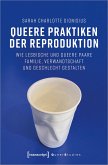- Broschiertes Buch
- Merkliste
- Auf die Merkliste
- Bewerten Bewerten
- Teilen
- Produkt teilen
- Produkterinnerung
- Produkterinnerung
Warum verlassen junge Frauen ihre Heimatdörfer, warum bleiben junge Männer dort - häufig unverheiratet? In ihrer Studie untersucht Nancy Konvalinka diese Entwicklung am Beispiel eines spanischen Dorfes. Deutlich wird, dass sich das Haus als Ort der gemeinsamen (Re-)Produktion verändert hat und dass Bildungsmöglichkeiten die Lebensläufe der Frauen entscheidend beeinflussen. Die Studie lässt Rückschlüsse auf ähnliche Prozesse in anderen ländlichen Gegenden Europas zu. Why do young men born in many small villages in Spain tend, at the end of the twentieth century, to stay there to live, often…mehr
Andere Kunden interessierten sich auch für
![Biografische Verläufe von Frauen in der Prostitution Biografische Verläufe von Frauen in der Prostitution]() Julia WegeBiografische Verläufe von Frauen in der Prostitution74,99 €
Julia WegeBiografische Verläufe von Frauen in der Prostitution74,99 €![LGBTQ+ Intimacies in Southern Europe LGBTQ+ Intimacies in Southern Europe]() LGBTQ+ Intimacies in Southern Europe30,99 €
LGBTQ+ Intimacies in Southern Europe30,99 €![LGBTQ+ Intimacies in Southern Europe LGBTQ+ Intimacies in Southern Europe]() LGBTQ+ Intimacies in Southern Europe38,99 €
LGBTQ+ Intimacies in Southern Europe38,99 €![Nancy Chodorow and The Reproduction of Mothering Nancy Chodorow and The Reproduction of Mothering]() Nancy Chodorow and The Reproduction of Mothering97,99 €
Nancy Chodorow and The Reproduction of Mothering97,99 €![Nancy Chodorow and The Reproduction of Mothering Nancy Chodorow and The Reproduction of Mothering]() Nancy Chodorow and The Reproduction of Mothering97,99 €
Nancy Chodorow and The Reproduction of Mothering97,99 €![Science and Technology Studies Science and Technology Studies]() Stefan BeckScience and Technology Studies29,80 €
Stefan BeckScience and Technology Studies29,80 €![Queere Praktiken der Reproduktion Queere Praktiken der Reproduktion]() Sarah Charlotte DionisiusQueere Praktiken der Reproduktion38,00 €
Sarah Charlotte DionisiusQueere Praktiken der Reproduktion38,00 €-
-
-
Warum verlassen junge Frauen ihre Heimatdörfer, warum bleiben junge Männer dort - häufig unverheiratet? In ihrer Studie untersucht Nancy Konvalinka diese Entwicklung am Beispiel eines spanischen Dorfes. Deutlich wird, dass sich das Haus als Ort der gemeinsamen (Re-)Produktion verändert hat und dass Bildungsmöglichkeiten die Lebensläufe der Frauen entscheidend beeinflussen. Die Studie lässt Rückschlüsse auf ähnliche Prozesse in anderen ländlichen Gegenden Europas zu.
Why do young men born in many small villages in Spain tend, at the end of the twentieth century, to stay there to live, often remaining unmarried, while young women from the same villages tend to leave? In Gender, Work and Property, Nancy Konvalinka explores this phenomenon using the case of one small village in northwestern Spain, and she extrapolates her findings there to understand similar processes elsewhere in Europe.
Why do young men born in many small villages in Spain tend, at the end of the twentieth century, to stay there to live, often remaining unmarried, while young women from the same villages tend to leave? In Gender, Work and Property, Nancy Konvalinka explores this phenomenon using the case of one small village in northwestern Spain, and she extrapolates her findings there to understand similar processes elsewhere in Europe.
Produktdetails
- Produktdetails
- Arbeit und Alltag 4
- Verlag: Campus Verlag / University of Chicago Press
- Artikelnr. des Verlages: 39661
- Seitenzahl: 294
- Erscheinungstermin: Januar 2013
- Englisch
- Abmessung: 213mm x 140mm x 22mm
- Gewicht: 386g
- ISBN-13: 9783593396613
- ISBN-10: 3593396610
- Artikelnr.: 34540431
- Herstellerkennzeichnung Die Herstellerinformationen sind derzeit nicht verfügbar.
- Arbeit und Alltag 4
- Verlag: Campus Verlag / University of Chicago Press
- Artikelnr. des Verlages: 39661
- Seitenzahl: 294
- Erscheinungstermin: Januar 2013
- Englisch
- Abmessung: 213mm x 140mm x 22mm
- Gewicht: 386g
- ISBN-13: 9783593396613
- ISBN-10: 3593396610
- Artikelnr.: 34540431
- Herstellerkennzeichnung Die Herstellerinformationen sind derzeit nicht verfügbar.
Nancy Konvalinka, Ph. D., lehrt Social and Cultural Anthropology an der Universität Madrid, Spanien.
ContentsIntroductionFieldwork and methodology1. Practical, Usable Value TheoryValue theory in anthropologySpecific problems of value and gender, localized in a Leonese village2. The Casa as a Unit of Production, Reproduction, and Consumption: The First Half of the 20th CenturyCovering an extended time period to study processesDemography and social structure at the beginning of the 20th centuryThe agent of decision: person, family or casa?The casa as a unit of production, reproduction, and consumptionWhat is the casa?Who are the members of the casa?Rural capitalValue and gender during the first half of the 20th centuryThe distribution of work among men and womenInteriorness and exteriornessInheritance and differential uses of rural capital: men's permanence and women's mobilityReproducing the casaMarried couples and children: the agents involved in reproducing the casaLife courses and vital conjuncturesOrientation of the casa toward the future3. Local Dimensions of a General Transformation: 1960-1979Changing circumstances: industrialization, emigration, and mechanizationLife courses and vital conjuncturesThe appearance of the categories of optionality, tastes, and preferencesEmigration and the accumulation of capital: You only needland to marry if you are going to stay in the villageMechanizationThe introduction of milk productionValues and gender repositioned: rural capital and interior and exterior spacesRural capital and men's and women's uses of itInterior and exterior spaces: the tasks change, but not thepositionsThe casa reproduces itself, but only in some of its childrenEmigration makes it possible to concentrate rural capital, a limited resourceMechanization as a catalyst of the processThe casas reproduce themselves, but only in some of theirchildren4. Casas and Sociedades: Splitting Meanings at the End of the 20th CenturyChanging circumstances: economic crisis and the reshaping of the family farmThe economic crisis and the reassessment of the casa as a job position for young menMechanization in the fields and in the stablesReconfiguration of the family farm: the sociedadesOption, taste, and preference: decisive factors in the formation of sociedadesWhen the children do not reproduce the casaDemographic profile, 1980-2000The configuration of the households, 1980-2000Values and gender repositioned: inheritance, schooling and lifecoursesSociedades and their consequences"The differences are less noticeable"Changes in schooling and their interactions with gender configurations and vital conjuncturesSeparating men's and women's life coursesThe casa as a unit of production, consumption, andreproduction no longer exists5. ConclusionsSome considerations about rural societyRural society is not static, nor has it been in the recent pastPeople make their decision in the framework of theirimmediate, relevant social environment, such as the familyor the casaThe processes of change develop along the axes of the structure that has existed up to that moment: Gender is a main axis that structures rural lifeAmbivalence toward rural lifeThe unexpected results of the changesConsiderations for a theory of value in relation to genderSocial subjects in their fields of value: processes of changePeopleThe casasThe villageSuggestions for a theory of value in relation to genderList of Diagrams, Figures, Graphs, and TablesWorks CitedIndexContents
Introduction
Fieldwork and methodology
1. Practical, Usable Value Theory
Value theory in anthropology
Specific problems of value and gender, localized in a Leonese village
2. The Casa as a Unit of Production, Reproduction, and Consumption: The First Half of the 20th Century
Covering an extended time period to study processes
Demography and social structure at the beginning of the 20th century
The agent of decision: person, family or casa?
The casa as a unit of production, reproduction, and consumption
What is the casa?
Who are the members of the casa?
Rural capital
Value and gender during the first half of the 20th century
The distribution of work among men and women
Interiorness and exteriorness
Inheritance and differential uses of rural capital: men's permanence and women's mobility
Reproducing the casa
Married couples and children: the agents involved in reproducing the casa
Life courses and vital conjunctures
Orientation of the casa toward the future
3. Local Dimensions of a General Transformation: 1960-1979
Changing circumstances: industrialization, emigration, and mechanization
Life courses and vital conjunctures
The appearance of the categories of optionality, tastes, and preferences
Emigration and the accumulation of capital: You only need
land to marry if you are going to stay in the village
Mechanization
The introduction of milk production
Values and gender repositioned: rural capital and interior and exterior spaces
Rural capital and men's and women's uses of it
Interior and exterior spaces: the tasks change, but not the
positions
The casa reproduces itself, but only in some of its children
Emigration makes it possible to concentrate rural capital, a limited resource
Mechanization as a catalyst of the process
The casas reproduce themselves, but only in some of their
children
4. Casas and Sociedades: Splitting Meanings at the End of the 20th Century
Changing circumstances: economic crisis and the reshaping of the family farm
The economic crisis and the reassessment of the casa as a job position for young men
Mechanization in the fields and in the stables
Reconfiguration of the family farm: the sociedades
Option, taste, and preference: decisive factors in the formation of sociedades
When the children do not reproduce the casa
Demographic profile, 1980-2000
The configuration of the households, 1980-2000
Values and gender repositioned: inheritance, schooling and life
courses
Sociedades and their consequences
"The differences are less noticeable"
Changes in schooling and their interactions with gender configurations and vital conjunctures
Separating men's and women's life courses
The casa as a unit of production, consumption, and
reproduction no longer exists
5. Conclusions
Some considerations about rural society
Rural society is not static, nor has it been in the recent past
People make their decision in the framework of their
immediate, relevant social environment, such as the family
or the casa
The processes of change develop along the axes of the structure that has existed up to that moment: Gender is a main axis that structures rural life
Ambivalence toward rural life
The unexpected results of the changes
Considerations for a theory of value in relation to gender
Social subjects in their fields of value: processes of change
People
The casas
The village
Suggestions for a theory of value in relation to gender
List of Diagrams, Figures, Graphs, and Tables
Works Cited
Index
Introduction
Fieldwork and methodology
1. Practical, Usable Value Theory
Value theory in anthropology
Specific problems of value and gender, localized in a Leonese village
2. The Casa as a Unit of Production, Reproduction, and Consumption: The First Half of the 20th Century
Covering an extended time period to study processes
Demography and social structure at the beginning of the 20th century
The agent of decision: person, family or casa?
The casa as a unit of production, reproduction, and consumption
What is the casa?
Who are the members of the casa?
Rural capital
Value and gender during the first half of the 20th century
The distribution of work among men and women
Interiorness and exteriorness
Inheritance and differential uses of rural capital: men's permanence and women's mobility
Reproducing the casa
Married couples and children: the agents involved in reproducing the casa
Life courses and vital conjunctures
Orientation of the casa toward the future
3. Local Dimensions of a General Transformation: 1960-1979
Changing circumstances: industrialization, emigration, and mechanization
Life courses and vital conjunctures
The appearance of the categories of optionality, tastes, and preferences
Emigration and the accumulation of capital: You only need
land to marry if you are going to stay in the village
Mechanization
The introduction of milk production
Values and gender repositioned: rural capital and interior and exterior spaces
Rural capital and men's and women's uses of it
Interior and exterior spaces: the tasks change, but not the
positions
The casa reproduces itself, but only in some of its children
Emigration makes it possible to concentrate rural capital, a limited resource
Mechanization as a catalyst of the process
The casas reproduce themselves, but only in some of their
children
4. Casas and Sociedades: Splitting Meanings at the End of the 20th Century
Changing circumstances: economic crisis and the reshaping of the family farm
The economic crisis and the reassessment of the casa as a job position for young men
Mechanization in the fields and in the stables
Reconfiguration of the family farm: the sociedades
Option, taste, and preference: decisive factors in the formation of sociedades
When the children do not reproduce the casa
Demographic profile, 1980-2000
The configuration of the households, 1980-2000
Values and gender repositioned: inheritance, schooling and life
courses
Sociedades and their consequences
"The differences are less noticeable"
Changes in schooling and their interactions with gender configurations and vital conjunctures
Separating men's and women's life courses
The casa as a unit of production, consumption, and
reproduction no longer exists
5. Conclusions
Some considerations about rural society
Rural society is not static, nor has it been in the recent past
People make their decision in the framework of their
immediate, relevant social environment, such as the family
or the casa
The processes of change develop along the axes of the structure that has existed up to that moment: Gender is a main axis that structures rural life
Ambivalence toward rural life
The unexpected results of the changes
Considerations for a theory of value in relation to gender
Social subjects in their fields of value: processes of change
People
The casas
The village
Suggestions for a theory of value in relation to gender
List of Diagrams, Figures, Graphs, and Tables
Works Cited
Index
ContentsIntroductionFieldwork and methodology1. Practical, Usable Value TheoryValue theory in anthropologySpecific problems of value and gender, localized in a Leonese village2. The Casa as a Unit of Production, Reproduction, and Consumption: The First Half of the 20th CenturyCovering an extended time period to study processesDemography and social structure at the beginning of the 20th centuryThe agent of decision: person, family or casa?The casa as a unit of production, reproduction, and consumptionWhat is the casa?Who are the members of the casa?Rural capitalValue and gender during the first half of the 20th centuryThe distribution of work among men and womenInteriorness and exteriornessInheritance and differential uses of rural capital: men's permanence and women's mobilityReproducing the casaMarried couples and children: the agents involved in reproducing the casaLife courses and vital conjuncturesOrientation of the casa toward the future3. Local Dimensions of a General Transformation: 1960-1979Changing circumstances: industrialization, emigration, and mechanizationLife courses and vital conjuncturesThe appearance of the categories of optionality, tastes, and preferencesEmigration and the accumulation of capital: You only needland to marry if you are going to stay in the villageMechanizationThe introduction of milk productionValues and gender repositioned: rural capital and interior and exterior spacesRural capital and men's and women's uses of itInterior and exterior spaces: the tasks change, but not thepositionsThe casa reproduces itself, but only in some of its childrenEmigration makes it possible to concentrate rural capital, a limited resourceMechanization as a catalyst of the processThe casas reproduce themselves, but only in some of theirchildren4. Casas and Sociedades: Splitting Meanings at the End of the 20th CenturyChanging circumstances: economic crisis and the reshaping of the family farmThe economic crisis and the reassessment of the casa as a job position for young menMechanization in the fields and in the stablesReconfiguration of the family farm: the sociedadesOption, taste, and preference: decisive factors in the formation of sociedadesWhen the children do not reproduce the casaDemographic profile, 1980-2000The configuration of the households, 1980-2000Values and gender repositioned: inheritance, schooling and lifecoursesSociedades and their consequences"The differences are less noticeable"Changes in schooling and their interactions with gender configurations and vital conjuncturesSeparating men's and women's life coursesThe casa as a unit of production, consumption, andreproduction no longer exists5. ConclusionsSome considerations about rural societyRural society is not static, nor has it been in the recent pastPeople make their decision in the framework of theirimmediate, relevant social environment, such as the familyor the casaThe processes of change develop along the axes of the structure that has existed up to that moment: Gender is a main axis that structures rural lifeAmbivalence toward rural lifeThe unexpected results of the changesConsiderations for a theory of value in relation to genderSocial subjects in their fields of value: processes of changePeopleThe casasThe villageSuggestions for a theory of value in relation to genderList of Diagrams, Figures, Graphs, and TablesWorks CitedIndexContents
Introduction
Fieldwork and methodology
1. Practical, Usable Value Theory
Value theory in anthropology
Specific problems of value and gender, localized in a Leonese village
2. The Casa as a Unit of Production, Reproduction, and Consumption: The First Half of the 20th Century
Covering an extended time period to study processes
Demography and social structure at the beginning of the 20th century
The agent of decision: person, family or casa?
The casa as a unit of production, reproduction, and consumption
What is the casa?
Who are the members of the casa?
Rural capital
Value and gender during the first half of the 20th century
The distribution of work among men and women
Interiorness and exteriorness
Inheritance and differential uses of rural capital: men's permanence and women's mobility
Reproducing the casa
Married couples and children: the agents involved in reproducing the casa
Life courses and vital conjunctures
Orientation of the casa toward the future
3. Local Dimensions of a General Transformation: 1960-1979
Changing circumstances: industrialization, emigration, and mechanization
Life courses and vital conjunctures
The appearance of the categories of optionality, tastes, and preferences
Emigration and the accumulation of capital: You only need
land to marry if you are going to stay in the village
Mechanization
The introduction of milk production
Values and gender repositioned: rural capital and interior and exterior spaces
Rural capital and men's and women's uses of it
Interior and exterior spaces: the tasks change, but not the
positions
The casa reproduces itself, but only in some of its children
Emigration makes it possible to concentrate rural capital, a limited resource
Mechanization as a catalyst of the process
The casas reproduce themselves, but only in some of their
children
4. Casas and Sociedades: Splitting Meanings at the End of the 20th Century
Changing circumstances: economic crisis and the reshaping of the family farm
The economic crisis and the reassessment of the casa as a job position for young men
Mechanization in the fields and in the stables
Reconfiguration of the family farm: the sociedades
Option, taste, and preference: decisive factors in the formation of sociedades
When the children do not reproduce the casa
Demographic profile, 1980-2000
The configuration of the households, 1980-2000
Values and gender repositioned: inheritance, schooling and life
courses
Sociedades and their consequences
"The differences are less noticeable"
Changes in schooling and their interactions with gender configurations and vital conjunctures
Separating men's and women's life courses
The casa as a unit of production, consumption, and
reproduction no longer exists
5. Conclusions
Some considerations about rural society
Rural society is not static, nor has it been in the recent past
People make their decision in the framework of their
immediate, relevant social environment, such as the family
or the casa
The processes of change develop along the axes of the structure that has existed up to that moment: Gender is a main axis that structures rural life
Ambivalence toward rural life
The unexpected results of the changes
Considerations for a theory of value in relation to gender
Social subjects in their fields of value: processes of change
People
The casas
The village
Suggestions for a theory of value in relation to gender
List of Diagrams, Figures, Graphs, and Tables
Works Cited
Index
Introduction
Fieldwork and methodology
1. Practical, Usable Value Theory
Value theory in anthropology
Specific problems of value and gender, localized in a Leonese village
2. The Casa as a Unit of Production, Reproduction, and Consumption: The First Half of the 20th Century
Covering an extended time period to study processes
Demography and social structure at the beginning of the 20th century
The agent of decision: person, family or casa?
The casa as a unit of production, reproduction, and consumption
What is the casa?
Who are the members of the casa?
Rural capital
Value and gender during the first half of the 20th century
The distribution of work among men and women
Interiorness and exteriorness
Inheritance and differential uses of rural capital: men's permanence and women's mobility
Reproducing the casa
Married couples and children: the agents involved in reproducing the casa
Life courses and vital conjunctures
Orientation of the casa toward the future
3. Local Dimensions of a General Transformation: 1960-1979
Changing circumstances: industrialization, emigration, and mechanization
Life courses and vital conjunctures
The appearance of the categories of optionality, tastes, and preferences
Emigration and the accumulation of capital: You only need
land to marry if you are going to stay in the village
Mechanization
The introduction of milk production
Values and gender repositioned: rural capital and interior and exterior spaces
Rural capital and men's and women's uses of it
Interior and exterior spaces: the tasks change, but not the
positions
The casa reproduces itself, but only in some of its children
Emigration makes it possible to concentrate rural capital, a limited resource
Mechanization as a catalyst of the process
The casas reproduce themselves, but only in some of their
children
4. Casas and Sociedades: Splitting Meanings at the End of the 20th Century
Changing circumstances: economic crisis and the reshaping of the family farm
The economic crisis and the reassessment of the casa as a job position for young men
Mechanization in the fields and in the stables
Reconfiguration of the family farm: the sociedades
Option, taste, and preference: decisive factors in the formation of sociedades
When the children do not reproduce the casa
Demographic profile, 1980-2000
The configuration of the households, 1980-2000
Values and gender repositioned: inheritance, schooling and life
courses
Sociedades and their consequences
"The differences are less noticeable"
Changes in schooling and their interactions with gender configurations and vital conjunctures
Separating men's and women's life courses
The casa as a unit of production, consumption, and
reproduction no longer exists
5. Conclusions
Some considerations about rural society
Rural society is not static, nor has it been in the recent past
People make their decision in the framework of their
immediate, relevant social environment, such as the family
or the casa
The processes of change develop along the axes of the structure that has existed up to that moment: Gender is a main axis that structures rural life
Ambivalence toward rural life
The unexpected results of the changes
Considerations for a theory of value in relation to gender
Social subjects in their fields of value: processes of change
People
The casas
The village
Suggestions for a theory of value in relation to gender
List of Diagrams, Figures, Graphs, and Tables
Works Cited
Index

